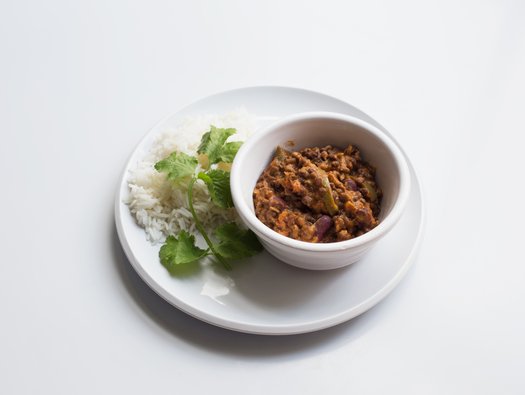Dal Makani

This warming recipe is great as a vegetarian main dish. Full of aromatic spices but no added salt, this delicious dal is a great low potassium, low phosphate and low protein meal.

This warming recipe is great as a vegetarian main dish. Full of aromatic spices but no added salt, this delicious dal is a great low potassium, low phosphate and low protein meal.
140g whole urad dal (black lentils)
100g tinned red kidney beans, drained
½ onion (approx. 50g), finely chopped
1-2 green chillies, finely chopped
2 teaspoons ginger and garlic paste
200g tinned tomatoes
½ teaspoon cumin seeds
3 cloves
3 green cardamom pods
1 black cardamon pod
1 cinnamon stick (approx. 2.5cm)
1 tej patta (Indian bay leaf)
½ teaspoon chilli powder
¼ teaspoon kasuri methi (fenugreek leaves)
¼ teaspoon ground nutmeg
60ml single cream
3 tablespoons unsalted butter
300g basmati rice
1 tablespoon tamarind paste
Soak the urad dal overnight or for 8-9 hours, in about 750ml water. Drain and rinse in fresh water. Add to a pan with a further 750ml water and simmer for 30 minutes until tender, then set aside. Finely chop the onion and chillies.
Heat the butter in a pan, add all the dry spices and sauté until aromatic.
Add the onions and fry until light golden. Add the ginger garlic paste and fry for a further 2-3 minutes. Add 1 teaspoon of chopped green chilli and stir for another minute. Add the tinned tomatoes, chilli powder and nutmeg, stir until the tomatoes are combined and the oil begins to separate.
Strain and add the urad dal and rajma with another 250ml water and simmer for 25-30 minutes.
Keep on a low heat until it begins to thicken, ensure that you stir regularly to stop the lentils from sticking. When the sauce has thickened stir in 50ml cream and turn off the heat. Crush the kasuri methi and add with the tamarind, stir again.
Bring saucepan of water to the boil. Rinse the rice and add to the boiling water. Cover and reduce the heat to a simmer for 20 minutes or until cooked. Serve the dal and rice drizzled with the remaining cream.
The rice is the main source of carbohydrate in this recipe, and the value has been provided for those who have been trained in insulin adjustment.
When served with rice, this dish is low in potassium and phosphate. If you choose to serve with naan bread this will increase the phosphate content. If you have been prescribed a phosphate binder, you should take as directed.
To lower the potassium in this recipe, we have used tinned red kidney beans, rather than dried, and chopped tomatoes instead of tomato puree.
This recipe is low in protein, therefore suitable for those advised to eat less protein. If you have been advised to eat more protein, you could double the quantity of urad dal (black lentils) and a portion would remain low in potassium.
Use vegetable oil in place of the butter and a dairy-free cream for a vegan alternative.
If you want to reduce the amount of saturated fat in this recipe swap the butter for vegetable oil and use a lower fat cream.
Make your own garlic and ginger paste (see below) and use 100% tamarind to avoid added salt.
If this is something you will make regularly then buying spices in larger quantities can often work out cheaper in the long term. You can make your own garlic and ginger paste by crushing 6 garlic cloves with 2.5cm of root ginger.
Allow to cool and store in an airtight container in the fridge for up to two days. Reheat thoroughly before serving. Do not reheat cooked rice.
Many of these ingredients can now be found in the supermarket, often in the world food aisle. Alternatively check to see if you have an Asian supermarket or buy online. If you cannot find urad dal, then black lentils or mung beans would be a suitable alternative. If you cannot find kasuri methi you may find them as dried fenugreek leaves. Alternatively, use fresh coriander, parsley or spring onions. Tej patta is an Indian bay leaf. Never substitute it with a European bay leaf because the flavour is entirely different. If you can’t find it, simply omit them from the dish or consider using a piece of cinnamon bark instead.
By giving us your email address, you're giving us permission to send you the latest news from Kidney Care UK. Further information about how we protect and use your personal data is available in our Privacy policy. If you would like to change the way we communicate with you at any time please email [email protected]. You can unsubscribe at any time by using the link at the bottom of every email we send.